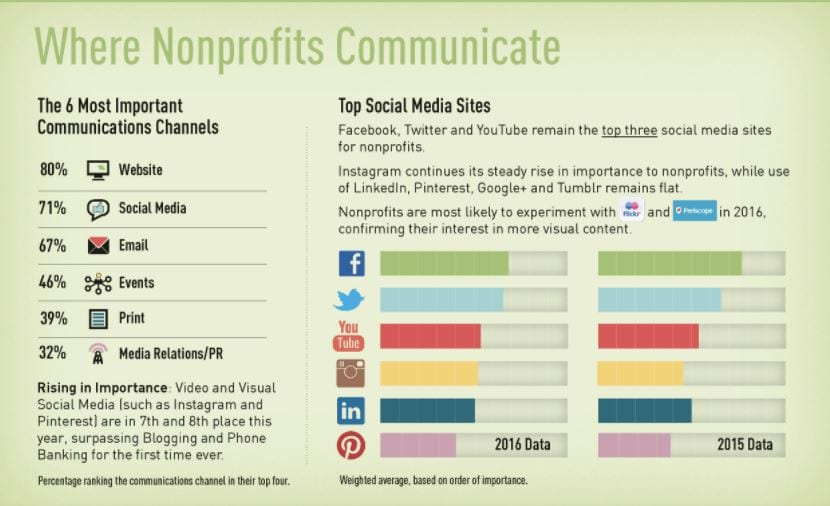If you think church marketing is challenging, you’re not alone. It can be difficult to find the right balance in marketing that’s effective and cutting-edge but still feels authentic to your church’s mission and culture.
But you don’t need to settle, and if you avoid the same church marketing mistakes, you’ll be on the right track.
This blog post will discuss eight church marketing don’ts you should avoid at all costs. These honest mistakes can be deadly to your marketing results over time. And as a bonus just for you, we’ll cover eight church marketing best practices to help you reach people the right way.
Estimated reading time: 1 minute
Table of contents
- What Exactly Is Church Marketing?
- 8 Church Marketing Don’ts to Avoid
- 1. Don’t say yes to everyone all the time.
- 2. Don’t spread yourself too thin.
- 3. Don’t use cheesy or over-the-top marketing tactics.
- 4. Don’t be afraid to try new things.
- 5. Don’t neglect the basics.
- 6. Don’t let your social media feed become an event bulletin board.
- 7. Don’t ignore accountability.
- 8. Don’t feel guilty about marketing.
- 8 Church Marketing Do’s to Put Into Place
- Church Marketing Mistakes
- Further Resources on Church Marketing
What Exactly Is Church Marketing?

Church marketing involves promoting the mission, values, and activities of a church to its congregation and the wider community. It’s about effectively communicating the message of faith, fostering community engagement, and inviting people to participate in the church’s activities.
Let’s explore more about church marketing.
Understanding Your Audience
Understanding the audience is essential in church marketing. Churches serve diverse communities with varying needs, interests, and backgrounds. By understanding the congregation and the broader community, churches can tailor their marketing efforts to resonate with their audience effectively.
Churches can gather insights about their audience through surveys, feedback forms, and personal interactions. Understanding demographics such as age, socioeconomic status, cultural background, and interests helps in crafting relevant and engaging marketing messages.
Moreover, churches should consider the needs and preferences of both existing members and potential visitors. For instance, families with young children may appreciate child-friendly programs and events, while young adults may seek opportunities for spiritual growth and community involvement.
Utilizing Communication Channels
Effective communication channels are crucial for reaching and engaging with the target audience. Churches can utilize various channels to communicate their message, including:
- Social Media: Platforms like Facebook, Instagram, and Twitter provide opportunities to share updates, event invitations, inspirational messages, and connect with members and the community.
- Church Website: A well-designed church website serves as a central hub for information about services, events, staff, beliefs, and contact details. It should be user-friendly, mobile-responsive, and regularly updated with fresh content.
- Email Marketing: Building an email list allows churches to send regular updates, newsletters, event invitations, and prayer requests directly to members’ inboxes. Personalized emails help in fostering engagement and community connection.
- Word of Mouth Marketing: Encouraging members to invite friends, family, and colleagues to church events and services can be a powerful marketing tool. Personal recommendations and positive experiences often lead to new visitors and increased community engagement.
According to Capterra, the most important communication channels for nonprofits (including churches) are websites, social media, and email.

By utilizing a mix of communication channels, your church can effectively reach and engage with its audience, ensuring that your message is heard and understood.
Creating Engaging Content
Creating engaging content is key to capturing the attention and interest of the audience. Churches can create various types of content to communicate their message effectively:
- Sermons and Teachings: Inspirational and relevant sermons that address the needs and concerns of the congregation can serve as a cornerstone of church communication.
- Visual Content: Visual content such as videos, graphics, and photos can help convey messages more effectively and capture the audience’s attention on social media and the church website.
- Testimonials and Stories: Sharing personal testimonies and stories of transformation can inspire and connect with the audience on a deeper level, showcasing the impact of faith in people’s lives.
- Event Announcements and Invitations: Promoting upcoming events, programs, and activities through compelling invitations and announcements encourages participation and community involvement.
By creating engaging content that resonates with the audience, your church can effectively communicate its message of faith. This builds community connections and inspires meaningful engagement.
Church marketing is about understanding the audience, utilizing communication channels effectively, and creating engaging content to communicate the message of faith and foster community engagement. By implementing these basics of church marketing, churches can effectively reach, connect, and inspire their congregation and the wider community.
8 Church Marketing Don’ts to Avoid

Churches can fall into one of two extremes in their marketing efforts: either they’re desperate to chase the latest trends, or they don’t do anything, and their church becomes irrelevant.
In addition, what works in one church might not work in another, and what works today might be outdated by tomorrow. It’s easy to fall into some of the common church marketing mistakes we’ve outlined below, but we’ll discuss how to avoid them and what to do instead to build your church marketing strategy.
1. Don’t say yes to everyone all the time.
Anyone who works in a church knows that you have multiple ministries, events, and priorities vying for advertising space. Your team is filtering an avalanche of incoming requests, and it can be challenging to say no to these good causes.
But broadcasting every event and ministry can be overwhelming for people. And it also sends the message that you’re insider-focused.
Someone not currently attending your church won’t understand the lingo or how they fit into the picture.
Your church marketing team has limited time, resources, and money. So it’s essential to be strategic about what gets announced (as well as when and where you communicate it).
Key question: Is our marketing strategy based on our audience’s needs or our internal demands?
2. Don’t spread yourself too thin.
You have limitless opportunities to be creative, from traditional marketing to internal projects to digital strategies. However, nobody has the resources to maximize every single channel, so you must pick and choose wisely.
And while you need a well-rounded church marketing strategy, if you charge forward with unrealistic expectations, you have a recipe for disaster. It will be difficult to avoid team burnout and frustration on all ends.
Spreading yourself too thin leads to subpar results across the board. It’s better to focus on a few church marketing initiatives and do them with excellence than try to tackle everything and end up with mediocre results.
Key question: What marketing channels are most effective and are we focused on those, or have we taken on too much?
3. Don’t use cheesy or over-the-top marketing tactics.
We’ve all seen corny commercials before. They’re often memorable because they are cringey. But you never want to make people feel like they’re being sold to or manipulated.
Although the saying, “there’s no such thing as bad publicity,” may hold true for some businesses and industries, we can’t say the same for churches.
When people look for a church (even if they’ve never stepped foot in one before), they want a safe place with trustworthy people. Nobody wants to risk their spiritual health and family’s well-being!
So, although a gimmicky marketing tactic may catch their attention, it won’t necessarily earn their trust – that’s where the wrong style of church marketing can backfire on you. In addition, you don’t want to make any false promises, or people will be disappointed when they walk through your doors.
Key question: Are we marketing out of desperation to get noticed or authentically representing our church family?
4. Don’t be afraid to try new things.

Even though we just talked about avoiding cheesy gimmicks, that doesn’t mean you shy away from trying new techniques, styles, and content. As a general rule, churches tend to lag in creative and innovative marketing.
Thinking “out-of-the-box” is not the same as being “over-the-top,” although we can get confused between the two and err on the side of being overly cautious.
Also, if you’re terrified of failure, you’ll get stuck playing it too safe and using old, tired techniques.
When you try new things, you won’t get it right 100% of the time; part of the cost of innovation is the occasional flop. But remember, if you’re not trying to improve and stay fresh, you’ll fade into the background noise.
Key question: How often are we trying something new in our marketing strategy?
5. Don’t neglect the basics.
An exciting aspect of church marketing is that there’s always a brand-new tool, platform, or strategy to utilize.
But don’t neglect your foundations. Church marketing fundamentals like solid branding, a well-designed website, local search engine optimization (SEO), and consistent email communication will always be necessary. They may not be as flashy, but they work.
If you don’t have these church marketing basics in place, no amount of bells and whistles will make up for it. And if you have an outdated website or you’re inconsistent in your marketing communication, then people will be frustrated.
Key question: Do we have solid and excellent church marketing basics in place?
6. Don’t let your social media feed become an event bulletin board.
Why do people use social media? While staying updated and informed is one primary reason people use social media, finding funny and entertaining content is equally important to users. According to the Digital Report 2021, other reasons people use social media include
- Filling up spare time
- Staying in touch with friends
- Networking
- Meeting new people
- Sharing photos or videos
As you can see, social media is all about relationships. So, as a church, if you’re only talking about yourself and your events, you’re missing the point of being social.
Your church’s social media strategy should provide valuable content that is inspiring and helpful to people. Otherwise, they’ll scroll on by to find something that serves them.
Key question: Are our social media feeds about what we want from people or what they want to see?
7. Don’t ignore accountability.
When you’re spending time and budget on marketing, it’s a huge mistake to be vague about your goals and performance.
Operating without a strategy and clearly defined budget is simply poor stewardship. Your church marketing efforts can’t be feelings based or change on a whim.
And part of being accountable means measuring your progress and tracking the right metrics so you can determine what’s working and where you need to make adjustments.
Maybe you’re dumping money into Facebook ads and getting a poor ROI. You need to choose a different strategy, get help, or push pause, so you’re not dumping money down the drain.
Key question: Do we have clear goals and track the right metrics?
8. Don’t feel guilty about marketing.
We know businesses have to market themselves, but what about churches? You may wonder if it’s biblical and ethical because it sounds strange to combine the words “church” and “marketing.”
But the purpose of church marketing is to find effective ways to share the good news of Jesus Christ with those who need to hear it. It’s not about selling a product or becoming rich and famous.
Consider your motives and goals, and find language to express those genuinely – that’s what church marketing is all about!
Key question: Are we holding back from reaching more people because of incorrect mindsets around marketing?
8 Church Marketing Do’s to Put Into Place

Now that you know some common church marketing pitfalls to avoid let’s focus on some tips you can take action on for a church marketing plan for growth.
1. Do be strategic with your yes.
Before you can start saying yes or no to marketing channels and requests, you must put a plan and strategy in place.
- What are your church’s mission and core values?
- Who is your target audience?
- What are the goals of your leadership team?
- What channels are most effective for your particular church?
Once you know the answers to these questions, you can focus on marketing opportunities and where to invest your time.
Next, you need to make sure everyone understands the strategy and guidelines. For example, maybe you only use social media ads for events that have the goal of reaching an external audience.
Or you specify what information you’ll share on social media main feeds, and what you’ll share in stories.
Having these kinds of policies takes the guesswork out of planning and helps your colleagues and church leaders understand where and how they can communicate.
2. Do be truthful and sincere
Sometimes, it’s tempting to make your church marketing mirror the big church down the street with lots of followers. Or try to appeal to as many people as possible.
But if you’re not being authentic, you’re not doing anyone any favors.
When you’re honest about who you are and what you believe, people can make an informed decision about whether or not your church is right for them. And if they do visit, they know what to expect because your marketing accurately tells the story of who you are.
So be yourself. Also, try to use original photos and videos instead of stock footage whenever possible.
Building an authentic brand is a more effective long-term strategy than catching peoples’ eye momentarily.
3. Do be creative
It’s ok to borrow ideas or see what’s working for other churches for inspiration. But don’t stop there; take another creative step.
Your church is unique, and your marketing should reflect that. You have the opportunity to stand out and connect with people in a way that feels fresh and new. They don’t want carbon copies of what they’ve already seen from hundreds of other churches.
Take time to brainstorm and look beyond churches to see what innovative businesses and marketing agencies are doing.
Also, remember that creativity takes many forms beyond artistic expression. Consider creative options for your strategies and tactics as well as your content.
4. Do utilize keywords and SEO

SEO, or search engine optimization, is the practice of optimizing your website and content to rank higher in search engine results. Social media platforms also use keywords and SEO to determine which content to show users.
When you’re creating church marketing materials, be mindful of the keywords and phrases people might use to search for a church like yours. Use those keywords throughout your website and social media platforms to help people find you more easily.
People may not be familiar with Christianese phases or technical theological terms, and that’s not what they’re searching for. For example, people are much more likely to search for a phrase like “need marriage help” than they are “sanctification in marriage.”
Research which keywords and phrases are most popular in your area and church demographic, and use those in your church marketing.
5. Do build a team
Digital marketing is getting increasingly complicated. And if you’re trying to do it all yourself, you will feel overwhelmed and frustrated.
Your church marketing team doesn’t have to be huge or only include staff. You can build a volunteer team to help with things like
- Photography
- Social media
- Graphic design
- Website maintenance
- Video production
- Research
- And more
Look for people with a passion for creativity and who are willing to learn and grow. You can also look for church members with experience and skillsets in these areas.
Finally, consider the advantages of partnering with other churches or outsourcing. Of course, not every church can afford its own web developer. But you can find someone to do contract work for a much lower cost than hiring someone full-time.
6. Do utilize social media
Social media is a powerful tool for most churches to connect with people and share their message of faith. Through platforms like Facebook, Instagram, and Twitter, churches can reach out to their community in a more immediate and personal way.
By posting updates, photos, and videos on social media channels, your church can keep its congregation informed about upcoming events, sermons, and activities. It’s like having a digital bulletin board that everyone can access from anywhere.
Linking social media profiles to your church website is another great way to make information easily accessible. People can learn more about your church’s beliefs, mission, and values by visiting the website. They can also find details about service times, contact information, and resources for spiritual growth.
Social media provides a space for churches to share inspiring messages, uplifting stories, and words of encouragement. It’s a platform where people can engage with each other, ask questions, and find support. Trust us, you want a plan when it comes to social media, not a weak social media strategy.
7. Do implement email marketing
Implementing email marketing is a valuable way for churches to stay connected with their members and community. Here’s why it’s important and how it can be done effectively:
- Stay in Touch: Email allows your church to communicate important updates, events, and announcements directly to members’ inboxes.
- Personalization: With email, your church can personalize messages based on members’ interests, preferences, and involvement in the church community.
- Cost-effective: Email marketing is a cost-effective way to reach a large audience compared to traditional methods like printing flyers or advertisements.
- Easy to Share: Members can easily forward church emails to friends and family, helping to spread the word about upcoming events or sermons.
- Feedback and Engagement: Email provides an opportunity for members to respond, provide feedback, and engage with the church community.
- Promote Inclusivity: Email marketing ensures that all members, regardless of physical location, can stay connected with the church and participate in its activities.
By implementing email marketing strategies, your church can strengthen relationships with its members, foster a sense of community, and effectively communicate its message of faith and inclusion.
8. Do offer online resources
Offering online resources is an excellent way for churches to reach and engage with their community and beyond. By providing accessible materials and content, churches can nurture spiritual growth and community connections in the digital age.
Online resources such as podcasts, blogs, and downloadable study materials allow your members to engage with church teachings and messages at their convenience. These resources can cover a wide range of topics, including sermons, Bible studies, inspirational messages, and practical advice for daily living.
Moreover, online resources can extend the reach of your church beyond its physical location, allowing people from diverse backgrounds and locations to access valuable spiritual content.
Word of mouth marketing also plays a significant role in promoting online resources. When members find value in the content provided by their church, they are likely to share it with friends, family, and colleagues, expanding the church’s reach organically.
When you offer online resources, your church demonstrates its commitment to meeting the evolving needs of your community. It also provides avenues for spiritual growth and connection in an increasingly digital world.
Church Marketing Mistakes

Church marketing is vital for any church that wants to reach new people and grow. But it’s not always easy to get started or know what to do. You can set your church up for success by avoiding these church marketing don’ts. And by following the tips in this blog post, you’ll be well on your way to building an effective church marketing strategy.
What are some other church marketing don’ts you would add to this list? Share your thoughts in the comments below!




